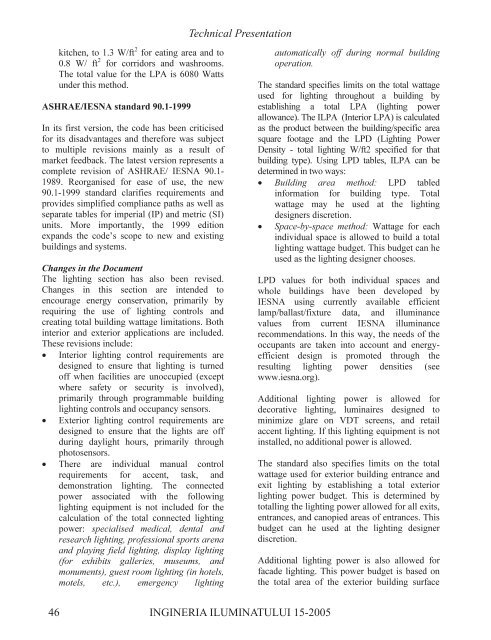Ingineria Iluminatului - Journal of Lighting Engineering - Prof. Florin ...
Ingineria Iluminatului - Journal of Lighting Engineering - Prof. Florin ...
Ingineria Iluminatului - Journal of Lighting Engineering - Prof. Florin ...
You also want an ePaper? Increase the reach of your titles
YUMPU automatically turns print PDFs into web optimized ePapers that Google loves.
46<br />
kitchen, to 1.3 W/ft 2 for eating area and to<br />
0.8 W/ ft 2 for corridors and washrooms.<br />
The total value for the LPA is 6080 Watts<br />
under this method.<br />
ASHRAE/IESNA standard 90.1-1999<br />
In its first version, the code has been criticised<br />
for its disadvantages and therefore was subject<br />
to multiple revisions mainly as a result <strong>of</strong><br />
market feedback. The latest version represents a<br />
complete revision <strong>of</strong> ASHRAE/ IESNA 90.1-<br />
1989. Reorganised for ease <strong>of</strong> use, the new<br />
90.1-1999 standard clarifies requirements and<br />
provides simplified compliance paths as well as<br />
separate tables for imperial (IP) and metric (SI)<br />
units. More importantly, the 1999 edition<br />
expands the code’s scope to new and existing<br />
buildings and systems.<br />
Changes in the Document<br />
The lighting section has also been revised.<br />
Changes in this section are intended to<br />
encourage energy conservation, primarily by<br />
requiring the use <strong>of</strong> lighting controls and<br />
creating total building wattage limitations. Both<br />
interior and exterior applications are included.<br />
These revisions include:<br />
• Interior lighting control requirements are<br />
designed to ensure that lighting is turned<br />
<strong>of</strong>f when facilities are unoccupied (except<br />
where safety or security is involved),<br />
primarily through programmable building<br />
lighting controls and occupancy sensors.<br />
• Exterior lighting control requirements are<br />
designed to ensure that the lights are <strong>of</strong>f<br />
during daylight hours, primarily through<br />
photosensors.<br />
• There are individual manual control<br />
requirements for accent, task, and<br />
demonstration lighting. The connected<br />
power associated with the following<br />
lighting equipment is not included for the<br />
calculation <strong>of</strong> the total connected lighting<br />
power: specialised medical, dental and<br />
research lighting, pr<strong>of</strong>essional sports arena<br />
and playing field lighting, display lighting<br />
(for exhibits galleries, museums, and<br />
monuments), guest room lighting (in hotels,<br />
motels, etc.), emergency lighting<br />
Technical Presentation<br />
INGINERIA ILUMINATULUI 15-2005<br />
automatically <strong>of</strong>f during normal building<br />
operation.<br />
The standard specifies limits on the total wattage<br />
used for lighting throughout a building by<br />
establishing a total LPA (lighting power<br />
allowance). The ILPA (Interior LPA) is calculated<br />
as the product between the building/specific area<br />
square footage and the LPD (<strong>Lighting</strong> Power<br />
Density - total lighting W/ft2 specified for that<br />
building type). Using LPD tables, ILPA can be<br />
determined in two ways:<br />
• Building area method: LPD tabled<br />
information for building type. Total<br />
wattage may he used at the lighting<br />
designers discretion.<br />
• Space-by-space method: Wattage for each<br />
individual space is allowed to build a total<br />
lighting wattage budget. This budget can he<br />
used as the lighting designer chooses.<br />
LPD values for both individual spaces and<br />
whole buildings have been developed by<br />
IESNA using currently available efficient<br />
lamp/ballast/fixture data, and illuminance<br />
values from current IESNA illuminance<br />
recommendations. In this way, the needs <strong>of</strong> the<br />
occupants are taken into account and energyefficient<br />
design is promoted through the<br />
resulting lighting power densities (see<br />
www.iesna.org).<br />
Additional lighting power is allowed for<br />
decorative lighting, luminaires designed to<br />
minimize glare on VDT screens, and retail<br />
accent lighting. If this lighting equipment is not<br />
installed, no additional power is allowed.<br />
The standard also specifies limits on the total<br />
wattage used for exterior building entrance and<br />
exit lighting by establishing a total exterior<br />
lighting power budget. This is determined by<br />
totalling the lighting power allowed for all exits,<br />
entrances, and canopied areas <strong>of</strong> entrances. This<br />
budget can he used at the lighting designer<br />
discretion.<br />
Additional lighting power is also allowed for<br />
facade lighting. This power budget is based on<br />
the total area <strong>of</strong> the exterior building surface
















